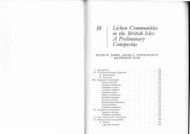You also want an ePaper? Increase the reach of your titles
YUMPU automatically turns print PDFs into web optimized ePapers that Google loves.
Many lichen species are fairly substrate specific<br />
to the extent that they are limited for the most<br />
part on bark or wood or silicate rock or limestone<br />
or soil and scarcely ever change over to other<br />
substrates. A further substrate related<br />
specialization is caused by pH conditions,<br />
nutrient supply, water capacity (water storage<br />
capacity) and other chemical and physical<br />
properties <strong>of</strong> the substrate. A few examples:<br />
Many bark lichens are limited to acid and<br />
nutrient poor bark and therefore are found<br />
predominately on conifer trees, others are<br />
specialized on base-rich bark, certain rock<br />
lichens live only on heavy-metal rich silicate<br />
rocks, others prefer fine granular, relatively<br />
porous calcareous rock. Very rotted wood is<br />
floristically distinct from tough and hard wood.<br />
pH Value<br />
Soil- as well as bark- and rock-dwelling lichens<br />
at times show pH characterized dependence. For<br />
example certain lichen species occur only upon<br />
calcareous and base rich soils, others only on<br />
very acid.<br />
The evidence for the critical point pHvalue<br />
<strong>of</strong> sites colonized by the species is<br />
supported by extensive pH-measurements with<br />
a portable pH-meter with a flat membrane<br />
electrode (see WIRTH 1972); they were for the<br />
most part accomplished on site on rain moistened<br />
or distilled water moistened substrates. The pH<br />
conditions were described as follows:<br />
Substrate Plants<br />
extremely acid - pH 3.3 extreme.<br />
acidophytic<br />
very acid pH 3.4-4.0 very acidophytic<br />
rather acid pH 4.1-4.8 rthr acidophytic<br />
moderately acid pH 4.9-5.6 mod acidophytic<br />
sub neutral pH 5.7-7.0 sub neutrophic<br />
neutral pH 7 neutrophic<br />
moderately basic pH 7.1-8.5 mod basic<br />
basic over pH 7 basic<br />
embracing a wide pH range euryion<br />
The non eutrophic and substantially unaltered by<br />
air pollution bark <strong>of</strong> conifers and birch is mostly<br />
very acid (stem); <strong>of</strong> spruce and black alder rather<br />
acid; <strong>of</strong> pear rather (-moderately) acid; <strong>of</strong> beech,<br />
ash, apple, and basswood moderately acid; while<br />
most poplars, Norway maples, sycamore, and<br />
elm, moderately acid to sub neutral; and black<br />
elder usually sub neutral.<br />
The buffering capacity in size and range nearly<br />
parallels the pH value: the higher the pH value<br />
the higher the buffering capacity. The buffering<br />
capacity attains a great significance, above all<br />
through the onset <strong>of</strong> wide distribution <strong>of</strong> acid air<br />
pollution, which acidifies the tree bark. A<br />
relatively high buffer capacity possessed by the<br />
bark <strong>of</strong> the ash, which <strong>of</strong>ten bears a flora, which<br />
is typical for trees with higher pH values. The<br />
sycamore is unchanged. Here a relatively small<br />
buffer capacity in the case <strong>of</strong> a relatively higher<br />
pH goes along with an <strong>of</strong>ten narrow acidophilic<br />
lichen flora.<br />
Mineral Content, Nutrient Content, and<br />
Eutrophication<br />
Only little is known today about mineral content<br />
and above all about the nutrient content ( in a<br />
narrower sense, foremost nitrogen and<br />
phosphorus compounds) <strong>of</strong> lichen inhabited<br />
substrates. Justifiable are statements about the<br />
extent <strong>of</strong> eutrophication <strong>of</strong> the habitat by animal<br />
manuring (e.g. bird roosts), by dust films (tree<br />
bark, rocks, walls, etc.) and by mineral fertilizer<br />
(vineyard walls). For the ecological characterization<br />
<strong>of</strong> the lichens <strong>of</strong> this kind <strong>of</strong> habitat one<br />
can use the relatively appropriate and neutral<br />
expression “coniophytic” (in the case <strong>of</strong> dust<br />
impregnation) and “coprophytic” (in the case <strong>of</strong><br />
animal manuring). Here is employed a known but<br />
without doubt truly problematic term based on<br />
the nitrogen content: “nitrophytic”; here it makes<br />
use <strong>of</strong>, the quantity <strong>of</strong> nutrient supply to<br />
illustrate.<br />
Substrate: Plant:<br />
not eutrophic anitrophytic<br />
moderately eutrophic m. nitrophytic<br />
(m. nutrient-rich)<br />
rather eutrophic rthr. Nitrophytic<br />
( rather-nutrient rich)<br />
very eutrophic v. nitrophytic<br />
(strongly nutrient-rich)<br />
extremely eutrophic ext. nitrophytic<br />
(extremely nutrient-rich)<br />
Perhaps tree bark on the interior <strong>of</strong> extensive<br />
forests are not eutrophic, bark <strong>of</strong> field and<br />
avenue trees rather eutrophic, extremely etrophic<br />
are very nitrogen-rich habitats as well as very<br />
strongly dunged tops <strong>of</strong> bird roosts, the dog urine<br />
impregnated base <strong>of</strong> walls, and the surfaces near<br />
manure piles. Rock habitats naturally nutrientpoor<br />
are not eutrophic, but not counting others in<br />
18





